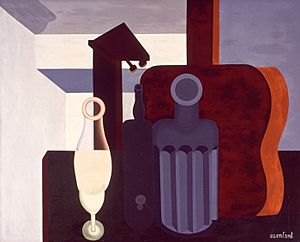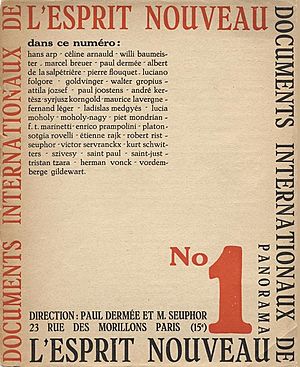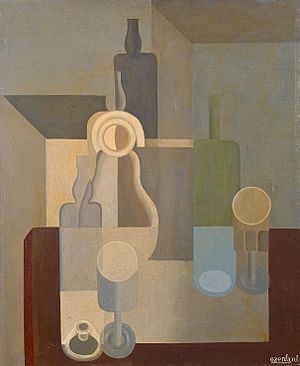Amédée Ozenfant facts for kids
Amédée Ozenfant (born April 15, 1886 – died May 4, 1966) was a French painter and writer. He was known for his unique style. With Charles-Edouard Jeanneret, who later became famous as Le Corbusier, he started a new art movement called Purism.
Contents
Early Life and Learning
Amédée Ozenfant grew up in a well-off family in Saint-Quentin, France. He went to school at Dominican colleges. After finishing school, he returned home and began painting with watercolour and pastels.
In 1904, he took drawing classes in Saint-Quentin. The next year, in 1905, he moved to Paris to study decorative arts. He learned from teachers like Maurice Pillard Verneuil.
By 1907, Ozenfant was studying at the Académie de La Palette. There, he became friends with other artists like Roger de La Fresnaye. He started showing his paintings in big art shows in Paris, like the Salon de la Société Nationale des Beaux-Arts in 1908.
Working with Le Corbusier and Creating Purism
Between 1909 and 1913, Ozenfant traveled a lot. He visited countries like Russia, Italy, and the Netherlands. In 1915, he started his own magazine called L’Elan. He edited it until 1916. During this time, his ideas for Purism began to take shape.
In 1917, he met Le Corbusier, a Swiss architect and painter. Together, they wrote a book called Après le cubisme (After Cubism). In this book, they explained their new ideas about Purism. The book came out at the same time as the first Purist art show in Paris, where Ozenfant showed his work.
They worked together again on a magazine called L'Esprit Nouveau (The New Spirit). This magazine was published from 1920 to 1925. It helped spread their ideas about art and design.
Another Purist exhibition happened in 1921. In 1924, Ozenfant opened a free art studio in Paris called Académie Moderne. He taught there with other famous artists like Fernand Léger. Ozenfant and Le Corbusier wrote another book, La Peinture moderne (Modern Painting), in 1925.
In 1928, Ozenfant published his book Art. It was later translated into English as The Foundations of Modern Art in 1931. In this book, he fully explained his ideas about Purism.
His Ideas on Color in England
Ozenfant later opened his own art school, l’Académie Ozenfant. He moved to London in 1936 and started the Ozenfant Academy of Fine Arts. Two years later, he moved to New York City. He taught many students in both London and New York.
At first, in Purism, color was not seen as important as the shapes and forms in a painting. But when Ozenfant was in England, he changed his mind about color. He wrote six articles for the Architectural Review magazine about it. He now believed that color was a very important part of architecture, not just something added at the end.
Ozenfant thought that color always changes how a building looks. He felt it needed more careful thought. He wanted to bring more order and sense to how color was used in design.
His new ideas about color were partly influenced by the artist Paul Signac. Signac had theories about Divisionism, an art technique. This technique involved putting small dots of pure color next to each other. When you looked at them from a distance, the colors would blend in your eye. This made the colors look brighter and prevented them from becoming muddy.
Ozenfant suggested using a similar idea for architecture. He called it "color solidity." This meant using colors in a way that made parts of a building look more solid or three-dimensional. This became important as modern buildings started using lighter materials like glass walls.
In 1937, Ozenfant said that architects and designers would benefit from a special color chart. This chart would have about a hundred different colors chosen for their specific needs.
Ozenfant's articles about color were very popular. Students at the Architectural Association in London read them with great interest. His ideas even influenced how some early post-war schools in England were decorated.
Later Years
The Ozenfant School of Fine Arts in New York operated from 1939 to 1955. He became a citizen of the United States in 1944. Ozenfant taught and gave many talks across the U.S. until 1955. Then, he moved back to France. He lived there for the rest of his life and passed away in Cannes in 1966.
Collections
Many famous museums around the world have paintings by Amédée Ozenfant. These include the Solomon R. Guggenheim Museum in New York City, the Hermitage Museum, the Museum of Modern Art (New York City), and the Tate Gallery in London.
See also
 In Spanish: Amédée Ozenfant para niños
In Spanish: Amédée Ozenfant para niños
- Crystal Cubism





